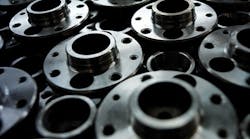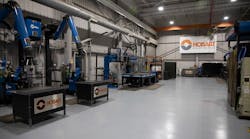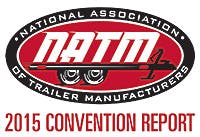FATIGUE: the process of cumulative damage in a benign environment that is caused by repeated fluctuating loads and, in the presence of an aggressive environment, is known as corrosion fatigue.
That’s how Dr John M. Barsom and Dr Stanley T Rolfe—experts in the application of fracture mechanics—define fatigue.
They’ve refined what’s been around for years, according to Duane K Miller, manager of engineering services and a welding design consultant for the Lincoln Electric Company.
“That’s been our basic approach to fatigue for many, many years: If it breaks, make it bigger. Some of us engineer our products with a system called “make it/break it/fix it,” and your fix is usually making it bigger. After doing it, we add in costs.
“Let me suggest to you that for welding systems, that approach is worthless.”
“How many of you have pressure in your company to reduce production costs? How many have to reduce material costs? We have to make due with less. We have to do it faster. We need lighter weight trailers and the temptation is to go to higher strength steels, and that brings us some real challenges to welding applications.”
Miller showed some photos of bridges—including the Golden Gate Bridge and Sydney Harbour Bridge—that he said are basically lap-welded gusset plates that were formerly riveted gusset plates.
“In the early ‘50s when we made the transition from rivets to welds, there were a variety of fatigue problems associated with these bridges,” he said. “So in late ‘50s and early ‘60s, the Federal Highway Administration did fundamental research into the fatigue behavior of welding connections. Everybody’s fatigue system around the world was based on the fundamental system established in the US.”
He said the Society of Automotive Engineers’ (SAE) system is based on that same system, as is the International Institute of Welding’s system. That methodology is codified in the American Institute of Steel Construction (AISC) specification, which can be downloaded for free at aisc.org. Appendix 3 has a title designed for fatigue, including a formula for aluminum on trailers: “You take the stress range allowable for steel and divide it by three, and you can use it for your aluminum.”
What causes fatigue?
According to Barsom and Rolfe, “Fatigue damage of components subjected to normally elastic stress fluctuations occurs at regions of stress (strain) raisers where the localized stress exceeds the yield stress of the material. After a certain number of load fluctuations, the accumulated damage causes the initiation and subsequent propagation of a crack, or cracks, in the plastically damaged regions.
“Welding technology is complex and fabrication by welding encompasses characteristics that should be understood to different levels by the design engineer, the fabricator, and the welder. Some of these characteristics pertinent to the present discussion are residual stresses, imperfections, and stress concentrations.”
Imperfections include: cracks in the weld; incomplete joint penetration in CJP; incomplete joint penetration in CJP; incomplete fusion; porosity; and slag inclusions.
Stress concentrations happen in weld toes, the unfused root of a single-sided PJP groove weld, weld toes in tee joints, and weld toes and weld roots in cruciform joints.
According to the AISC 360-10 specification’s Appendix 3:
Extensive test programs using full-size specimens, substantiated by theoretical stress analysis, have confirmed the following general conclusions (Fisher et al, 1970; Fisher et al, 1974): Stress range and notch severity are the dominant stress variables for welded details and beams.
Stress range is defined as “the magnitude of the change in stress due to the application or removal of the service live load.”
“Other variables such as minimum stress, mean stress and maximum stresses are not significant for design purposes; and structural steels with a specified minimum yield stress of 36 to 100 ksi (250 to 690 MPa) do not exhibit significantly different fatigue strengths for given welded details fabricated in the same manner.” ♦











